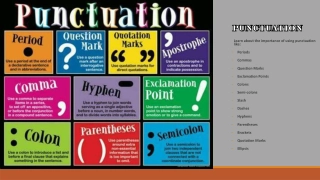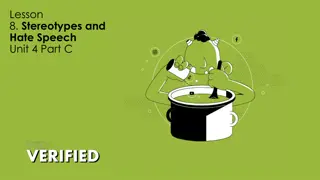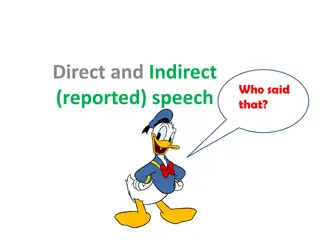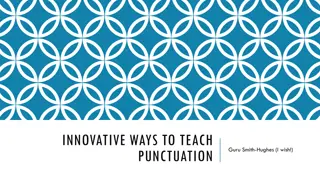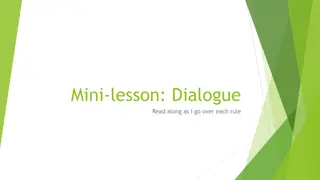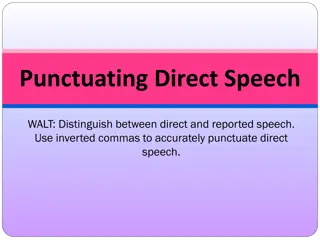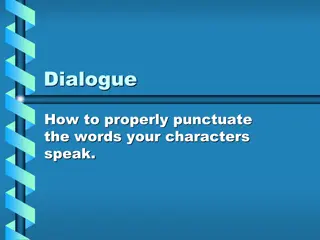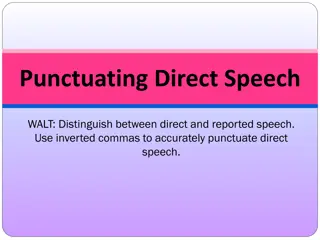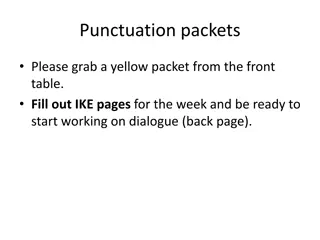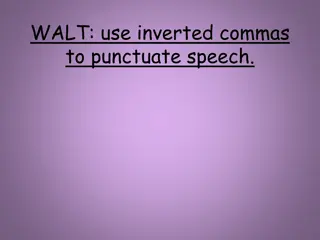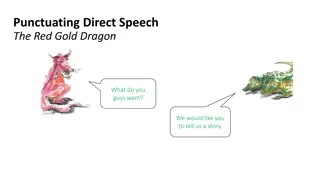Speech Marks and Punctuation in Dialogue
Proper usage of speech marks and punctuation in dialogue is crucial for effective communication. Speech marks indicate the exact words spoken by a character, while punctuation helps convey tone and emotion. Learn where to place speech marks, closing punctuation, and how to start a new line for each character speaking. Practice punctuating dialogue to enhance clarity and bring conversations to life.
Uploaded on Feb 24, 2025 | 0 Views
Download Presentation

Please find below an Image/Link to download the presentation.
The content on the website is provided AS IS for your information and personal use only. It may not be sold, licensed, or shared on other websites without obtaining consent from the author.If you encounter any issues during the download, it is possible that the publisher has removed the file from their server.
You are allowed to download the files provided on this website for personal or commercial use, subject to the condition that they are used lawfully. All files are the property of their respective owners.
The content on the website is provided AS IS for your information and personal use only. It may not be sold, licensed, or shared on other websites without obtaining consent from the author.
E N D
Presentation Transcript
Using Speech Marks
Speech marks go around the bits of a sentence actually being spoken. Hello, Blab! Hello, Blob! What a surprise seeing you here! Hello, Blab! exclaimed Blob. Hello, Blob! replied Blab. What a surprise seeing you here!
We also need to put some punctuation at the end of each piece of dialogue before we close the speech marks - ! ? , . Do you believe it? Charlie asked. I don t believe it! cried Kate. Believe it or not, Ben shrugged, it s true. Amy nodded. I believe it.
Where should the speech marks and closing punctuation go in these sentences? a. Would you like a sweet Tom asked. Would you like a sweet? Tom asked. b.I d love to come to your party Sam exclaimed. I d love to come to your party! Sam exclaimed. c. That was a really sad story sniffed John. That was a really sad story, sniffed John. d.If you d like it Alice murmured have it. If you d like it, Alice murmured, have it.
We also need to start a newline every time a differentcharacter speaks. Hello, Mr. Batt! called James. Hello there! replied Mr. Batt. How are you feeling today? James asked, stopping at Mr. Batt s gate. I m fine, thanks James, smiled Mr. Batt, just no more football for a while!
Oh. Ive always wanted my own kitten. Remember, it won t stay a kitten for long! Try to turn this speech into dialogue.
Now, you need to think about the speech too.
Now, think about the speech in this situation.
Try punctuating this dialogue: Bodget and Brown looked hard at the chimney. It was leaning a very long way over. It will have to be pulled down said Bodget, as he and the constable looked up at the chimney. It can not be left in that state said the constable. You had better get started. I have told Mrs. Worth about it. We will go and get some ladders and scaffolding from the lorry said Bodget and off he went.
Now, check your dialogue punctuation: Bodget and Brown looked hard at the chimney. It was leaning a very long way over. "It will have to be pulled down," said Bodget, as he and the constable looked up at the chimney. "It can not be left in that state," said the constable. "You had better get started. I have told Mrs. Worth about it." "We will go and get some ladders and scaffolding from the lorry," said Bodget and off he went.
We need to remember: 1. Put speech marks around the words being spoken. 2. Punctuate the speech before closing speech marks. 3. Start a new line for each new speaker. Don t use too much dialogue to tell stories.


